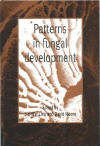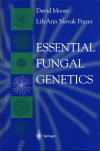12. The epigenetic context
The main lesson to learn from other organisms bears on the question of the ultimate level of morphogenetic control. It is clear that in animals and plants morphogenesis is not simply a matter of playing out a predefined genetic programme and it is likely that this will be true for fungi also. Goodwin (1984) states that the '...developmental process involves principles of organisation ... which are not caused by genes in the way that computer output is caused by a program.' Instead, he argued that macromolecular and cellular structures, such as the cytoskeleton and endomembrane system, provide a more promising foundation for describing the forces which define morphogenetic fields during animal embryogenesis. Those fields of force, thought to include electrical, chemical and mechanical effects, are modified by, and themselves modify, the expression of specific gene products.
Trewavas (1986) developed a similar argument about the involvement of growth substances in plant development. Rather than the abstraction 'fields of force', Trewavas (1986) likened plant development to a network of metabolic processes. Interactions between metabolic pathways create the network and the form of the tissue or organ changes in response to introduction of new components and/or new links within the network. Trewavas (1986) was keen to argue against the common notions that growth substances in plants serve as limiting factors which act in direct 'cause and effect' pattern. He argued that these ideas are best replaced by the concept of sensitivity to control. This sees the network as reaching a state which is able to react to the growth substance (or the inverse interpretation: the growth substance is such that it alone can disturb an otherwise stable network). Edelman (1992) emphasised three observations which are key to his own morphoregulator hypothesis. These three points are:
- expression of developmentally important genes is epigenetic and place-dependent, relying on previously-formed tissue structures;
- the driving forces of morphogenesis are cellular in origin, namely cell division, movement (Edelman is concerned with animal embryogenesis), adhesion and death;
- the links between gene expression and the mechanical driving forces are molecular, proteins , growth factors and adhesion molecules.
Edelman's (1992) morphoregulator hypothesis for animal systems is essentially a network in which he places particular importance on adhesion molecules (cell-to-substratum and cell-to-cell adhesion) and cell junctional molecules. These molecules are the products of differentially-expressed (that is, developmentally regulated) genes, but the gene products interact epigenetically to modulate the cell surface. The cell surface phenotype which results may then itself induce further differentiation and/or development-specific changes. In other discussions the part played by mechanical tensions in animal morphogenesis has also been stressed.
Bard (1990) provides a general discussion, but Van Essen (1997) concludes his review of morphogenesis of the mammalian central nervous system with this paragraph:
'..Morphogenesis entails an intricate choreographing of physical forces that cause differential tissue growth and displacement. Does this require an elaborate set of developmental instructions, transcending those needed to regulate the processes of neural proliferation, migration, axonal path-finding, and synapse formation? If morphogenesis is driven largely by tension, the answer is no. Instead, the specificity of shape changes would largely be a by-product of factors that dictate the connectivity and topology of the underlying neural circuitry. This constitutes an efficient strategy for sharing the instructions that guide neural development.'
Even though he places his emphasis on mechanical tension, Van Essen's argument is clearly fundamentally epigenetic and of exactly the same sort as those featured earlier in this section.
It is interesting that the embryologist (Edelman, 1992) emphasises externalised molecules involved in adhesion, whilst the botanist (Trewavas, 1986) emphasises interactions between internal metabolic pathways (albeit influenced by growth substances from outside the cell). Goodwin (1984) is more inclusive, mentioning mechanical and electrical as well as chemical fields as components of the 'organised context' within which developmental genes operate. Despite these cultural differences, all of these interpretations stress the role of networks of complex interactions in specifying morphogenetic stages. In such contexts, properties are shared throughout the network because of the interconnections. Thus, change in one part results in a response by the whole. The more complex the interactions, the more stable the state.
The concept also envisages, however, that introduction (or removal) of a component will have sufficient influence to alter the state of the network. This helps to explain how changes in morphogenesis can depend on discrete events such as differential expression of just a few genes, or one specific environmental variable. Genes which can be characterised as developmental genes are those whose products have sufficient epigenetic impact to shift the network to a new state. Similarly, a network sensitised by its intrinsic structure to a particular environmental variable will shift in response to that variable but will be insensitive to other variables.
Again, the common observation of numerous (sometimes small) changes characterising an altered state of differentiation can also be accommodated. The assumption in this case is that these phenotypic features comprise a collection of characters which result from the interactions within the network. When the network shifts in response to a signal to which it is sensitive, all those interactions change. As a consequence, all of the characters in the collection which defines the present state of differentiation are likely to alter as the network shifts to a new state of differentiation. The differentiation signal may be correlated with many of the morphogenetic changes it induces, but may not cause them directly. Their cause lies within the network of interactions. If the signal and the morphogenetic change are studied in isolation, away from the network, it may not be possible to demonstrate any connection between them at all.
The key to fungal morphogenesis lies in understanding how that which is outside a hypha can influence that which goes on inside the hypha in a time- and place-dependent manner. Exactly the same can be said for animals and plants. The fungal situation is no less complex, and certainly no less interesting, than these other eukaryotes. Mycologists must learn to think much more in developmental terms; the fungi had it all sorted out several hundred million years ago! [TOP]
Updated December 7, 2016










